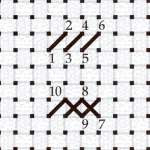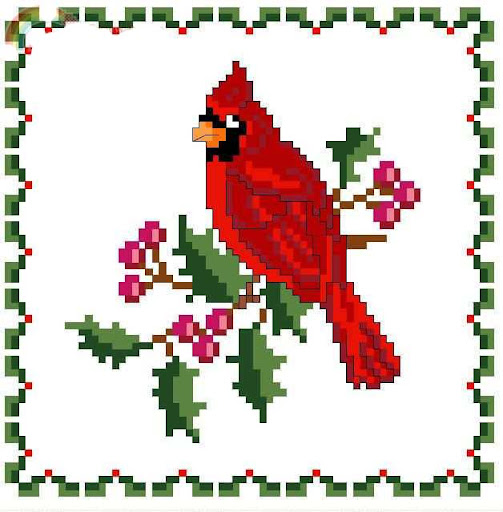To Start
It is best to centre the cross stitch design by starting in the middle so that your stitching fits onto the piece of fabric without going off to one side. An easy way to do this is to lightly fold the fabric in four to find the centre point. This point should coincide with the centre of the chart, which is normally marked with arrows at the top, bottom and sides. The centre of the design is normally the best place to start stitching.Most stranded cotton threads (floss) are made up of six strands. Seperate these out into the correct number of strands (as indicated on the chart instructions) for stitching. The colour key shows which shade of cotton to use for each symbol on the chart.
Start Stitching
To begin the cross stitch, thread your needle and bring it up through the fabric, leaving a short end of cotton at the back, and work over this with your first few stitches to secure it. When there are enough stitches in place you can start off a new colour by first running it through the back of the existing stitches. To finish a colour, run your cotton under several stitches at the back to secure it. |
 |
Working a single cross stitch
The fabric shown in the diagram on the left is aida, and it is very popular for cross stitch. This is a block weave fabric, with a hole at the corners of each block, which is nice and easy to work. Imagine that each block is represented by one square on the chart. To make one cross stitch: bring the needle up through hole 1, down through hole 2, then up through hole 3, and finally down through hole 4. |
Working a row of cross stitch
To make a row of cross stitches: work across the fabric in the order shown on the top part of the diagram on the right, and then back to complete the crosses as shown on the bottom part. Always cross over in the same direction. It is quicker to work cross stitches in rows wherever possible. Try not to join up separate areas of the same colour with long runs of thread at the back of the work. This is not only untidy and may show through the fabric at the front, but will probably mean you will run out of the thread supplied in the cross stitch kit. It is better to cut and fasten off your thread at the back of the needle work as normal, and start again at the new area of the design. |  |
 |
Working a Row of Half Cross Stitch
Many projects now have areas worked in half cross stitch, for example to give a "soft focus" background. This stitch is literally half of a cross stitch (up through 1 and down through 2 etc.), as shown on the left.
|
Work a row of Back Stitch
To make a row of back stitches: bring the needle up at 1, down at 2, up at 3, and down at 4, and so on, as shown on the diagram on the left. Notice that 1 and 4 use the same hole.Back stitch is used to great effect on many designs to delineate and bring out areas of stitching, adding drama and sharpness to the needle work. It is basically a row of stithes, maked on the chart by a row of lines. The back stitch is not normally worked until the cross stitch has been completed.
Back stitch is often worked with just a single strand of thread. |  |
 |
Working Part Stitches
It is sometimes necessary to have more than one colour on a single block of fabric. Imagine a cross stitch design with a dark grey sloping roof and a blue sky above it. If the roof slopes from the right up to the left the designer will often make a part stitch of blue in the top right of the fabric block and a grey part stitch in the bottom left of the same block. Where two colours share one square on the chart, work a 3/4 stitch in the more prominent shade, and complete the block with a 1/4 stitch of the other shade, as shown in the diagram on the left. Make your own hole with the needle in the centre of the block.
The combination of 1/4 stitch and 3/4 stitch often looks better than two 3/4 stitches, where you end up with a bulky four strands across the middle of a block of fabric. |
















